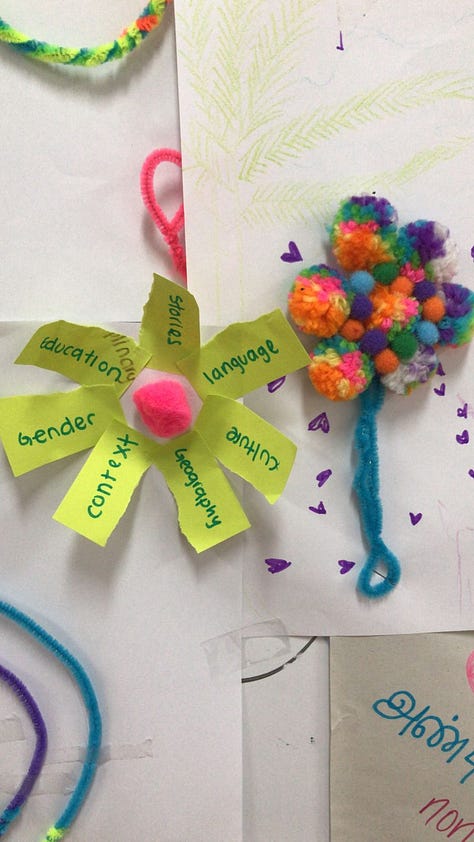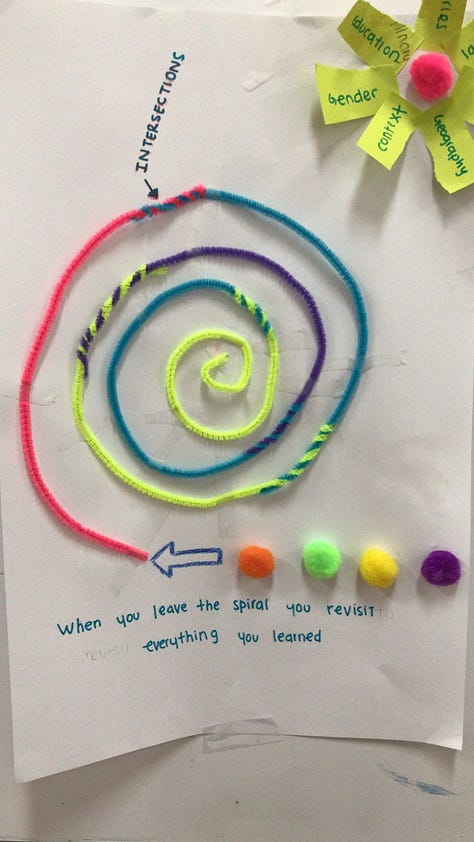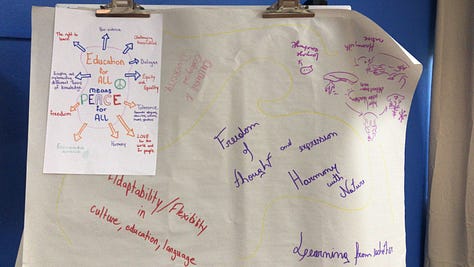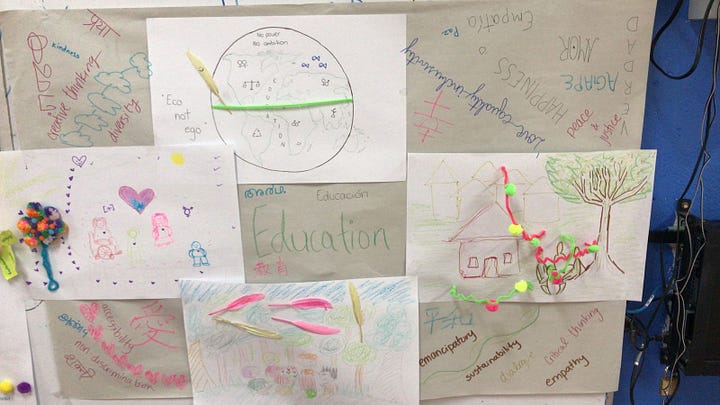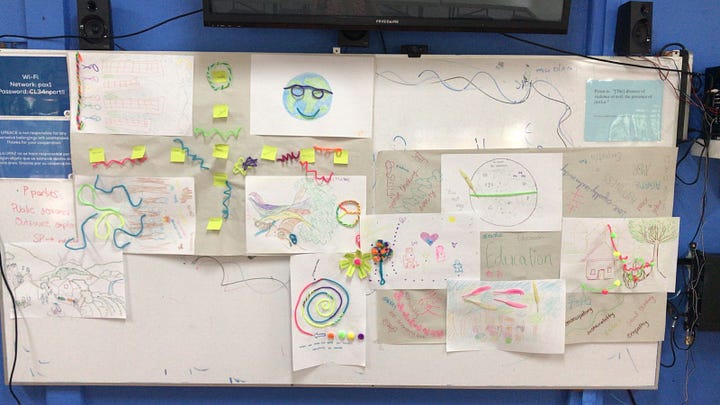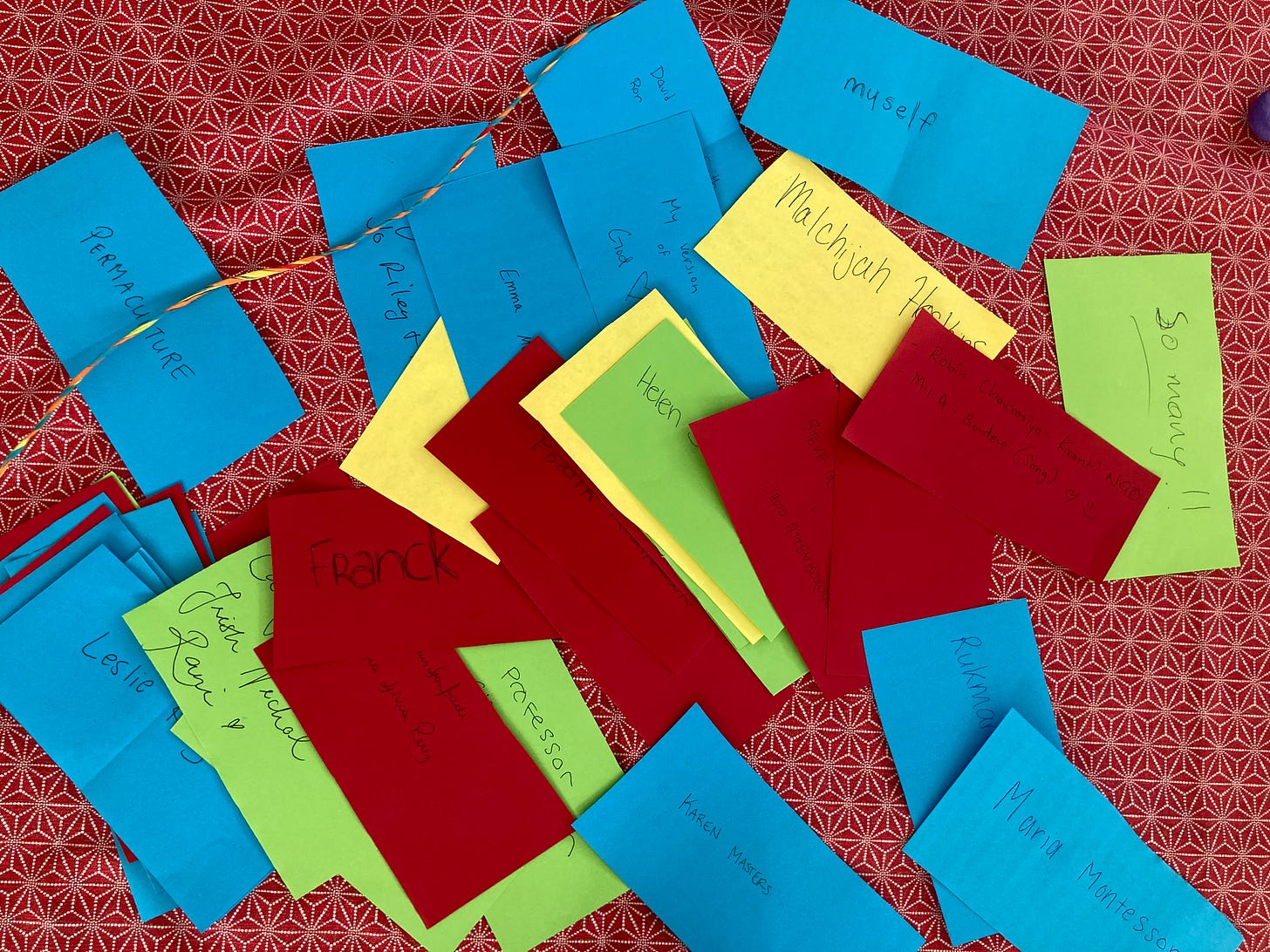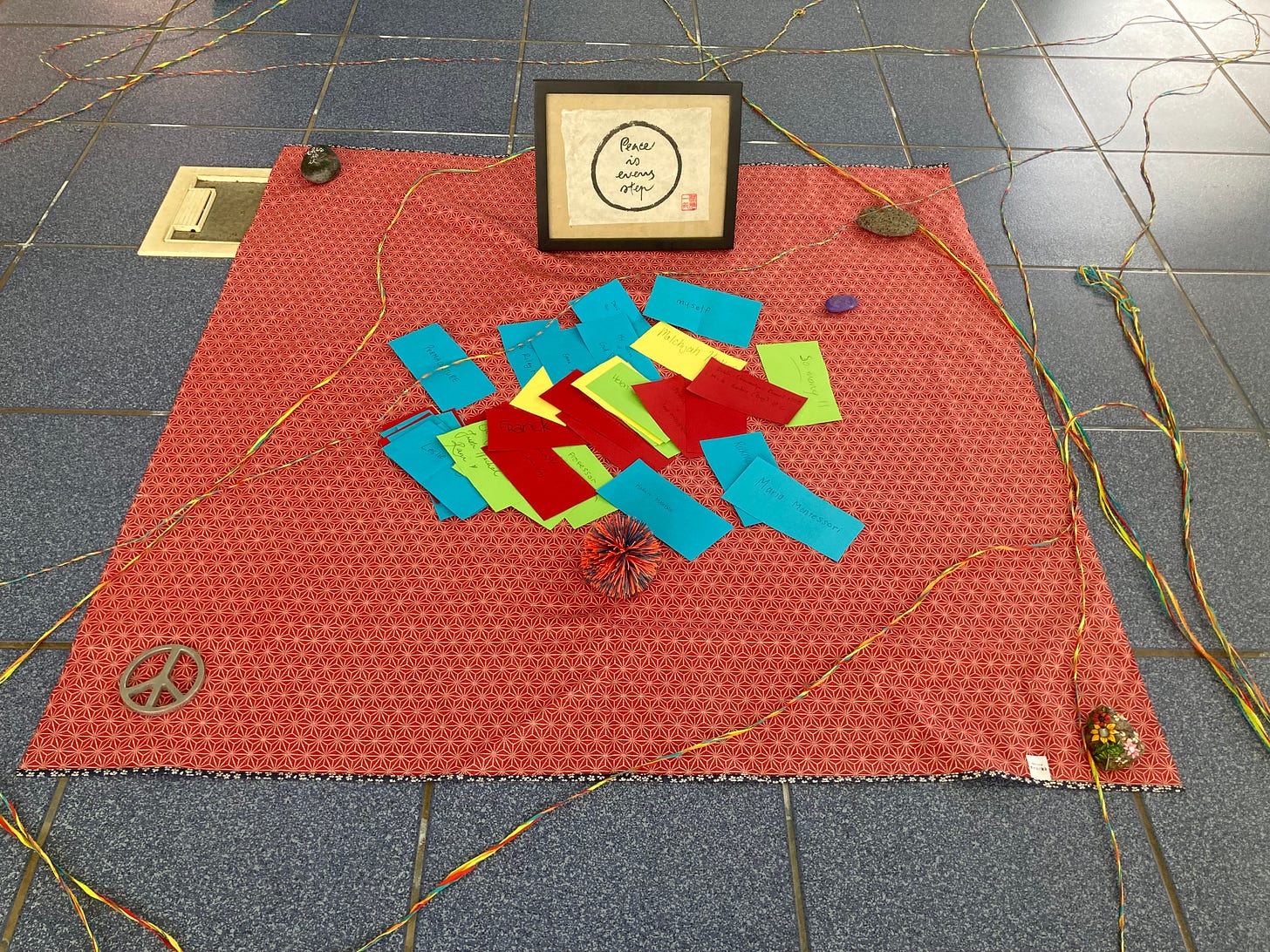
Dear readers,
I want to share with you my love letter lecture to the UPEACE class of 2024, which I delivered as my Foundations class lecture on Educating for Peace and Nonviolence this week. Foundations class is the one class that all UPEACE students take together, and I has one hour and fifteen minutes to share with them about peace education. It was delivered in a severe state of jet lag, having arrived home only about 13 hours before from the DRC Social Innovation Summit in the Congo. Because I knew I would be in this state of jet lag, I wrote the lecture out. This is (more or less) what I shared (albeit there was some riffing!). I thought you might enjoy it too. The accompanying slides can be found here.
For the educators in my readership, there is an accompanying lesson plan for an imaginination activity I did with the students after this lecture that you can find at the end of the letter.
I opened class with Good Day by the Seretones, Come as You Are by Nirvana, and Freedom by Jean Batiste.
Dear Class of 2024,
I am so happy and excited to be here with you today, and to have the chance to welcome you to your UPEACE journey. I hope you are feeling welcome and having a good experience so far. It is my pleasure and joy to welcome you here today. I hope you feel welcome, that every part of you feels welcome, and that you feel like you can bring your whole self here because we need you, all of you, just as you are.
In that spirit, I am going to invite you to take a few mindful breaths together and allow yourself to arrive. Notice how you are showing up today, how your body is feeling, and your energy, any feelings that are present, and I invite you to welcome yourself to this room, this space, to Zoom. Notice if there is anything you brought with you that you don’t need right now, that you can put down or leave behind, that you don’t need to carry with you this morning, including distractions. With a deep breath, I invite you to let that go, and bring your awareness to the others around you, in the physical and virtual space. Bring your attention to the learning community we are a part of, and feel yourself a part of this larger whole. And finally, feel the land that is holding us, here in Costa Rica and so many other parts of the world, the many conditions that allow us to be together, the air we are breathing, the electricity and fiberoptic cables connecting us, the many conditions of support that have allowed you to land in this moment. Welcome. Welcome, welcome.
For me, this is a precious moment, because this is the one chance I get to be with all of you. So as I was preparing for today, I was really thinking about how can I make the most of this very short time. What can share that would be of most value?
I wrote this lecture as a letter, a love letter to you. Because if we want to talk about educating for peace and nonviolence, we have to talk about love. After all, one way of describing nonviolence is love-in-action. And I know, this might be the cliché you imagine when you hear the words “peace education.” But joking aside, education is fundamentally about love – a love of learning, a love of life, and love for the world, and hopefully a love for each other that can transcend our differences and embrace our shared desires for happiness, living well, for a better world.
This isn’t just me making this up. Two of the most influential figures in my life and work as a peace educator, who are deeply influential for the peace education field as a whole, are bell hooks and Paulo Freire, both of whom were in your readings for last night, who were in dialogue with each other and influenced each other. Both of them talked a lot about love – bell hooks has a whole book about it – and both of them wrote extensively about how education is fundamentally about relationships, and that how we teach is just as if not more important than what (the content) we teach, and the radical possibilities that exist for education as a pathway towards liberation. To me, part of the work of peace education is to honor the roots we are coming from, the people whose shoulders we stand on, the lineages we carry, and to extend or reach beyond these lineages for the times we are living in.
In that spirit, I invite you to reflect on the lineages and roots that brought you here to UPEACE. Who have been the thinkers, the teachers, who brought you here, who influenced your path to come here? I invite you, in pairs or trios, to share briefly about that question. And I invite you to think about “teacher” expansively, as anyone or anything you have learned from, not just in formal settings.
(I then invited students to write the name of their teacher down and place it on the learning altar at the front of the room.)
I welcome all of our teachers into this room. May they support us in our pursuit of collective learning for peace.
I want to share a quote from bell hooks, from her seminal work Teaching to Transgress, in which she talks about creating a love ethic. She describes love as “a combination of care, commitment, knowledge, responsibility, respect, and trust…When these basic principles of love form the basis of teacher-pupil interaction the mutual pursuit of knowledge creates the conditions for optimal learning. Teachers, then, are learning while teaching, and students are learning and sharing knowledge” (p. 133).
This connects to your reading from Paulo Freire for today, in which he talks about the banking model of education and the student-teacher relationship. The banking model of education, a phrase that Freire coined, is an orientation towards education where the teacher is seen (and sees themselves) as the possessor of knowledge, and the students are empty receptacles to be deposited into, and then students show what they have “learned” by regurgitating what has been deposited into them. I would guess that most if not all of you have experienced this in some form, as it is common the world over.
Now, you might be saying, “Well, how can you be up there lecturing us about the banking model of education?! Isn’t that contradictory, or hypocritical?” And on one hand, yes, sure, it is. On the other hand, and as I see it, the banking model is more of an orientation than just a method. A lecture is a method, and I have been transformed by lectures before, by great teachers such as Thich Nhat Hanh. Maybe you have watched a TED talk which really impacted you or changed the way you think. I am not saying you’ll be transformed by today’s lecture, but that a lecture itself is not the equivalent of the banking model, that lectures themselves aren’t inherently bad.
The antidote to the banking system, is what Freire calls problem-posing education, where teachers and learners engage in horizontal (non-hierarchical) relationships, and together, through dialogue seek the root causes of the problems of their world, and develop agency to transform the conditions, moving from oppression towards liberation. A lofty goal, I know, but you wouldn’t be at UPEACE if you didn’t have lofty goals 😊 And I am sure you have already had many dialogues in the short time you have been here.
In that sense, the banking model and the problem-posing model of education are fundamentally about the relationships between teachers and students. When the relationship is based on domination and hierarchy, even if you are having dialogue, the banking model persists. But when the relationship is based on mutual respect, appreciation, openness, trust, and willingness to learn from each other, a more liberatory education is possible.
We need to be wary, though, of the overromanticization of this relationship and the denial of hierarchies that exist, even if we don’t want them to. I strive to cultivate horizontal relationships with my students – and yet, at the end of the day we are operating in a system in which we have agreed to conditions and roles, and for me it involves deciding your grades in order for you to receive your degree. Grading could be an entirely different lecture, but in this context I just want to say that we want to strive towards these more non-hierarchical relationships while at the same time being aware of the real ways that hierarchies persist despite our best intentions.
In chapter 3 of Pedagogy of the Oppressed (which was not in your reading last night because I couldn’t assign you the whole book - you’re welcome :), Freire discusses the relationship between dialogue and love. He writes:
“Dialogue cannot exist, however, in the absence of a profound love for the world and for people. The naming of the world, which is an act of creation and re-creation, is not possible if it is not infused with love. Love is at the same time the foundation of dialogue and dialogue itself. It is thus necessarily the task of responsible Subjects and cannot exist in a relation of domination. Domination reveals the pathology of love: sadism in the dominator and masochism in the dominated. Because love is an act of courage, not of fear, love is commitment to others. No matter where the oppressed are found, the act of love is commitment to their cause—the cause of liberation. And this commitment, because it is loving, is dialogical. As an act of bravery, love cannot be sentimental; as an act of freedom, it must not serve as a pretext for manipulation. It must generate other acts of freedom; otherwise, it is not love. Only by abolishing the situation of oppression is it possible to restore the love which that situation made impossible. If I do not love the world—if I do not love life—if I do not love people—I cannot enter into dialogue.”
Similarly to how I spoke about the lecture – as being a method and not an orientation – I want us to consider dialogue in this way. Yes, dialogue is a method, AND it is also an orientation, of openness, of deep listening, of seeking to understand (rather than to judge), of learning from others and being willing to change, to be changed. If you are entering into a “dialogue” with only the intention to win an argument, that is not true dialogue.
Now, where I see this going awry in progressive and transformative education circles is the belief that any dialogue is transformative, and that dialogue itself, as a method, as a pedagogical tool, is always the answer. As an orientation, yes, to be in dialogue and exchange is an answer, but as a method, I have seen too often the belief that if we just open the floor that magic will happen, and maybe it will, but not always, and sometimes without structure, without a container, without agreements and guidelines that we are upholding, dialogue can feel pointless, and can even be harmful when toxic dynamics are left unchecked.
And this is why, to me, one of the most important things you will do during your UPEACE experience, in your classrooms and as a campus community, is building a learning community. Weaving and reweaving community, every day. Within community, anything and everything is possible. In community, we can learn and unlearn together, we can make mistakes and repair harm, we can grow together and hold each other accountable. We can truly be in dialogue with one another. We can engage in the messy work of building peace together.
I want to return to that line from the Freire quote: Love is a commitment to others. You have committed to being here for this year, and we are committed to each other for this year. There will be people who are lifelong soul friends that you meet here – and id say most years there are at least one or two couples who meet here and get married and have babies together, or start organizations together, many lifelong partnerships of various sorts. But you are not going to be best friends with everyone, and probably in your programmes there will be a person or two who really get on your nerves or who don’t pull their weight on group projects. UPEACE itself is an experiment in intercultural peacelearning – how can we learn to live and learn together for a year in this community?
I think one of the most amazing things about the UPEACE experience is the immersive quality, that for this year, we are dedicating ourselves to the mutual pursuit of knowledge about peace. No matter what your programme, that is what we are here doing. You could have chosen anywhere, but you chose here, this instution with a lofty perhaps unreachable vision.
I invite and challenge you to make the most of it. I invite you to stay with the trouble of trying to create a more peaceful world.
Donna Haraway wrote a book called Staying With the Trouble, and I find it to be a useful invitation. I usually preface all of my classes with this, an invitation to stay with the trouble because the work of building a more peaceful, just, sustainable world is messy business. It is not linear, it is not perfect, and we are very much of, implicated by, and complicit with current systems of domination, separation and violence, to different degrees according to our location, position, etc., as we go about trying to build this other world. Staying with the trouble is about commitment. It’s saying, this is going to get messy, this is going to get uncomfortable, but I am going to stick with it. I’m going to try. I’m going to see this through. Im not going to give up right away. I’m going to try. (This doen’t mean there aren’t times to step away, to have boundaries, though).
And this is maybe a good time for me to bring in a practical tool I wanted to share with you today, the comfort, stretch, and panic zones of learning model. Staying with the trouble is trying to stay in this stretch zone. (See slide - I explain this diagram but did not write it out here).
Fundamentally, this place that you have chosen to study, the University for Peace, is an institution of peace education. Go out to the lobby and you’ll see our mission:
“to provide humanity with an international institution of higher education for peace and with the aim of promoting, among all human beings, the spirit of understanding, tolerance and peaceful coexistence, to stimulate cooperation among peoples and to help lessen obstacles and threats to world peace and progress, in keeping with the noble aspirations proclaimed in the Charter of the United Nations"
Education for peace means many things, is a very broad and encompassing term, as you hopefully saw in your reading last night from Monisha Bajaj and Maria Hanzopoulos.
[Slides about peace education - unscripted]
Bell hooks said that the classroom remains one of the most radical spaces of possibility in the academy. I invite you, as you relate to this institution and your own peace education, to embrace the radical possibilities of your journey here at UPEACE. Try to break beyond the binary of peace and not peace. Name the contradictions, develop your critiques and sit in the tensions. Stay with the trouble. Be slow to dismiss. Try to leave this place better than you found it. Be marked by this place, and leave your mark here to.
We do not claim to be perfect here. We are not the university OF peace. We are not saying are ARE peace, or that we have already achieved it. We are saying we are FOR peace. We are here for it. We stand for it. We are trying, and we are dedicated to it, in all our strengths and imperfections and failings. But we keep trying. Year after year, we are still here, and we keep trying to live into the dream that our lofty mission proclaims.
And my biggest invitation to you today is to keep imagining, dreaming, and reaching beyond. Reach beyond what we have created here, beyond what you can currently imagine. Push the edges, push the boundaries. Have your critique, which is so necessary, don’t get stuck there. Keep imagining beyond the possibilities of current systems and structures to a world, as Paulo Freire says, “where it is easier to love.” And that is what you will be doing in your dialogue session today, imaginging what education might look like in that world. I sincerely look forward to hearing about what you come up with, and look forward to the radical possibilities we can create together as a learning community this year. Thank you!
With love,
Professor Stephanie
P.S. Here is a link to the activity that followed, the Re-imagining Education Visioning Exercise! The images below are the art from one of the discussion groups.
